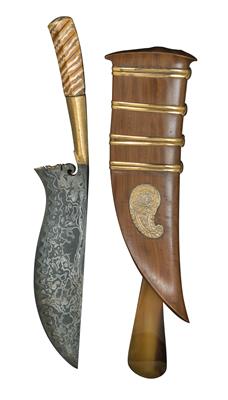Indonesia, Java: a nobleman’s ceremonial ’wedung’ knife, made of pamor steel, gold and an elephant’s molar.
Indonesia, Java: a nobleman’s ceremonial ’wedung’ knife, made of pamor steel, gold and an elephant’s molar.

Ceremonial and prestige knives such as this one, called ‘wedung’, belonged to the traditional outfit of noblemen in central Java, when they were invited to the sultan’s palace (‘Kraton’) for an audience, a ceremony or a feast.
The present ‘wedung’ is an especially opulent example of a ceremonial and ornamental knife: its large, single-edged blade consists of pamor steel forged with the utmost care from many different layers of iron (pattern type: ‘beras wutah’). The large lower end of the blade, shaped in waves, grooves and volutes, is covered in gold leaf. Similarly, the first half of the pentagonal hilt is covered with a relatively thick layer of gold all around. The edge of the gold application is decorated with a narrow engraved ornamental band and with a leaf pattern in relief on the underside near the blade. The other, external half of hilt, with slanted white, light and dark brown stripes, is made of the hard material of an elephant’s molar cut in a pentagonal shape. Die sheath of the ‘wedung’ is made of fine, brown precious wood and is covered in four double, golden bands.
The external side of the elegant sheath is decorated with an emblem in ‘mirabotta shape’, with blossoms and leafy tendrils. This emblem is made of gilt silver. A long, flexible hanger made of light-coloured horn is attached to the inside of the sheath by means of the golden bindings. It is used for lodging the ‘wendung’ in the belt of a ceremonial sarong.
Overall, the present ‘wedung’ is an especially valuable, opulent object that was reserved only for highest aristocratic circles of Java. This piece is preserved in excellent original condition (only minor traces of corrosion are detectable on the blade tip). 19th century; L: 46 cm (in total). (ME) ASA
Provenance: Austrian private collection.
Lit.: ‘Traditional weapons of the Indonesian Archipelago’ by A. G. van Zonneveld, ill. 641, 642, 643, 645.
Expert: Prof. Erwin Melchardt
 Prof. Erwin Melchardt
Prof. Erwin Melchardt
+43-1-515 60-465
erwin.melchardt@dorotheum.at
05.11.2014 - 13:00
- Odhadní cena:
-
EUR 3.600,- do EUR 4.000,-
Indonesia, Java: a nobleman’s ceremonial ’wedung’ knife, made of pamor steel, gold and an elephant’s molar.
Ceremonial and prestige knives such as this one, called ‘wedung’, belonged to the traditional outfit of noblemen in central Java, when they were invited to the sultan’s palace (‘Kraton’) for an audience, a ceremony or a feast.
The present ‘wedung’ is an especially opulent example of a ceremonial and ornamental knife: its large, single-edged blade consists of pamor steel forged with the utmost care from many different layers of iron (pattern type: ‘beras wutah’). The large lower end of the blade, shaped in waves, grooves and volutes, is covered in gold leaf. Similarly, the first half of the pentagonal hilt is covered with a relatively thick layer of gold all around. The edge of the gold application is decorated with a narrow engraved ornamental band and with a leaf pattern in relief on the underside near the blade. The other, external half of hilt, with slanted white, light and dark brown stripes, is made of the hard material of an elephant’s molar cut in a pentagonal shape. Die sheath of the ‘wedung’ is made of fine, brown precious wood and is covered in four double, golden bands.
The external side of the elegant sheath is decorated with an emblem in ‘mirabotta shape’, with blossoms and leafy tendrils. This emblem is made of gilt silver. A long, flexible hanger made of light-coloured horn is attached to the inside of the sheath by means of the golden bindings. It is used for lodging the ‘wendung’ in the belt of a ceremonial sarong.
Overall, the present ‘wedung’ is an especially valuable, opulent object that was reserved only for highest aristocratic circles of Java. This piece is preserved in excellent original condition (only minor traces of corrosion are detectable on the blade tip). 19th century; L: 46 cm (in total). (ME) ASA
Provenance: Austrian private collection.
Lit.: ‘Traditional weapons of the Indonesian Archipelago’ by A. G. van Zonneveld, ill. 641, 642, 643, 645.
Expert: Prof. Erwin Melchardt
 Prof. Erwin Melchardt
Prof. Erwin Melchardt
+43-1-515 60-465
erwin.melchardt@dorotheum.at
|
Horká linka kupujících
Po-Pá: 10.00 - 17.00
kundendienst@dorotheum.at +43 1 515 60 200 |
| Aukce: | Mimoevropské a domorodé umění |
| Typ aukce: | Salónní aukce |
| Datum: | 05.11.2014 - 13:00 |
| Místo konání aukce: | Wien | Palais Dorotheum |
| Prohlídka: | 31.10. - 05.11.2014 |
